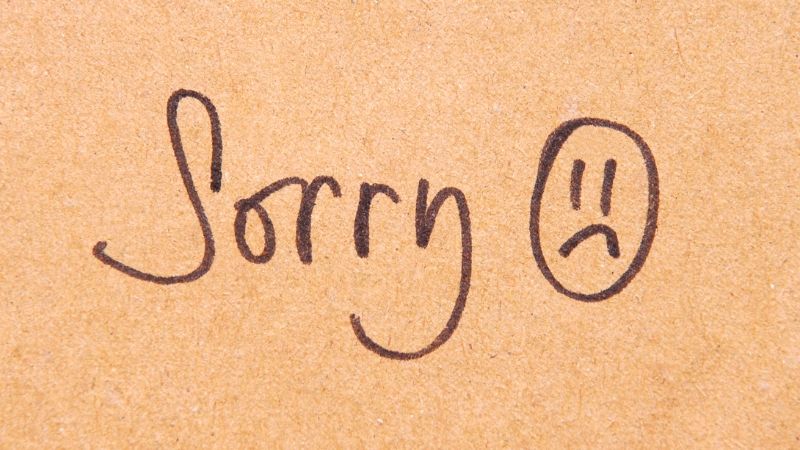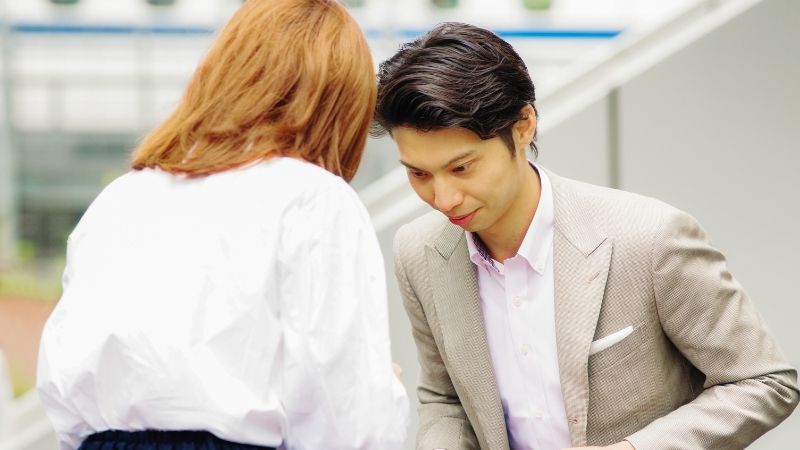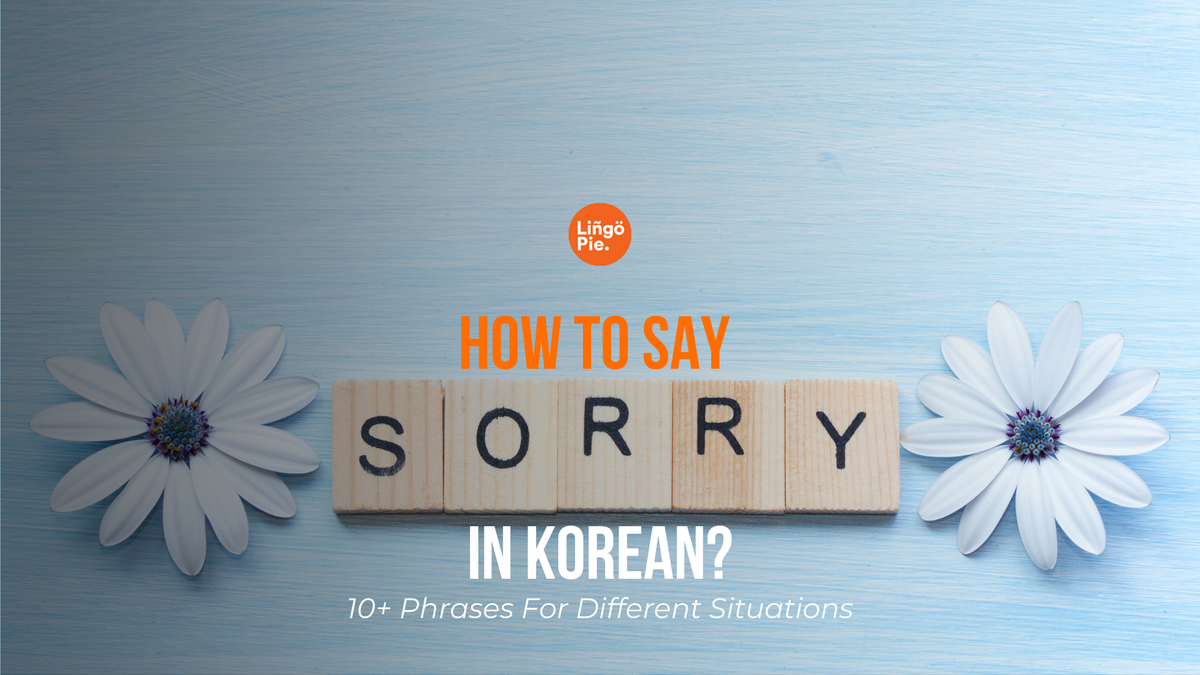Did you know that in Korea, a simple apology can be conveyed in several different ways, depending on the situation? Whether you're saying sorry to a friend, your boss, or a stranger, the formality of your apology matters.
When I first started learning Korean, I was surprised to find out just how important it is to know exactly how to apologize appropriately. I made plenty of small mistakes, but learning the nuances of Korean apologies helped me confidently navigate conversations.
In this post, I’ll walk you through the different ways to say sorry in Korean, from casual to formal, and explain when each form is appropriate. Along the way, I’ll also share some cultural tips on body language and etiquette that make your apology more sincere.
- Chuseok Guide For Foreigners
- Korean Beauty Standards
- How To Learn Korean With K-Pop?

1. How To Say Sorry In Korean?

미안해 (Mianhae) is the most casual way to say “sorry” in Korean, and it's typically used among close friends, family, or people of the same age group. Since it’s informal, you should avoid using it with strangers, elders, or in professional settings.
When to Use This Phrase:
- When you accidentally bump into a friend.
- When you forget to return a call or reply to a message.
- When you’re late meeting a close friend for dinner.
Examples:
- 미안해, 내가 늦었어.
Mianhae, naega neujeosseo.
"Sorry, I’m late." - 정말 미안해, 너한테 말 안 했어.
Jeongmal mianhae, neohante mal an haesseo.
"I’m really sorry I didn’t tell you."
Read Also:

2. How To Say Sorry In Korean Politely?
미안해요 (Mianhaeyo) is a more polite version of "sorry" and is used in semi-formal situations. It’s appropriate when speaking to acquaintances, younger colleagues, or people you aren't too familiar with, but with whom you want to show a bit more respect than with the casual 미안해.
When to Use This Phrase:
- Speaking with someone you’ve just met or don’t know very well.
- Apologizing to a neighbor or a younger colleague at work.
- Situations that are not too formal but still require politeness.
Examples:
- 미안해요, 제가 실수했어요.
Mianhaeyo, jega silsuhaesseoyo.
"I’m sorry, I made a mistake." - 늦어서 미안해요.
Neujeoseo mianhaeyo.
"Sorry for being late." - 문제 일으켜서 미안해요.
Munje ireukyeoseo mianhaeyo.
"I’m sorry for causing trouble."
3. Formal Sorry In Korean
죄송합니다 (Joesonghamnida) is the formal and respectful way to say “sorry” in Korean. This expression is used when you need to show a higher level of respect, such as when speaking to elders, superiors at work, or strangers in formal settings. It is important to use 죄송합니다 to ensure your apology is polite and appropriate for the situation.
When to Use This Phrase:
- Apologizing to your boss or in a workplace environment.
- Addressing elders or people in positions of authority.
- Interacting with strangers in formal or professional settings.
- In a formal meeting or business environment where professionalism is required.
- When making a public apology.
- When addressing a customer or client in a service setting.
Examples:
- 죄송합니다, 제가 보고서를 늦게 제출했습니다.
Joesonghamnida, jega bogoseoreul neutge jetchulhaetseumnida.
"I’m sorry, I submitted the report late." - 폐를 끼쳐 죄송합니다.
Pye-reul kkichyeo joesonghamnida.
"I’m sorry for the inconvenience." - 길을 막아서 죄송합니다.
Gireul magaseo joesonghamnida.
"Sorry for blocking your way."
Read Also:

4. Deep Apology In Korean For Serious Situations
정말 죄송합니다 (Jeongmal Joesonghamnida) is a stronger, more heartfelt version of 죄송합니다. Adding 정말 (which means "truly" or "really") emphasizes the depth of your apology, making it clear that you are genuinely sorry. This phrase is used in more serious situations, when you need to convey a deep sense of regret or when you’ve made a significant mistake.
When to Use This Phrase:
- When you've caused considerable trouble or inconvenience.
- In formal situations where a simple apology doesn’t seem sufficient.
- When apologizing for a serious error at work or in public.
- After disappointing someone in a significant way.
- When you've made a serious error at work, like missing a critical deadline or making a costly mistake.
- Apologizing to someone you’ve deeply offended or hurt.
- In situations where you need to show extreme sincerity, such as during a formal or public apology.
Examples:
- 정말 죄송합니다, 큰 실수를 저질렀습니다.
Jeongmal joesonghamnida, keun silsuleul jeojilleotseumnida.
"I’m truly sorry, I made a big mistake." - 정말 죄송합니다, 약속을 지키지 못했습니다.
Jeongmal joesonghamnida, yaksogeul jikiji mothaetseumnida.
"I’m really sorry, I couldn’t keep my promise." - 정말 죄송합니다, 제가 너무 무례하게 행동했습니다.
Jeongmal joesonghamnida, jega neomu muryehage haengdonghaetseumnida.
"I’m truly sorry, I acted very rudely."
5. Cultural Etiquette When Apologizing In Korean

In Korean culture, apologies go beyond just words—body language, facial expressions, and tone of voice all play significant roles in delivering a sincere apology. Understanding these cultural nuances will help you communicate your regret more effectively and appropriately.
Bowing and Its Significance
Bowing is an essential part of showing respect in Korean culture, especially when apologizing. The depth of the bow reflects the level of sincerity and respect:
- Small Bow (slight tilt of the head): Used in casual or less serious apologies, like bumping into someone lightly.
- Deeper Bow (from the waist): Reserved for more serious apologies or when addressing someone in a higher position of authority, such as elders, superiors, or in formal settings.
- Very Deep Bow (90-degree bow): Signifies deep regret and is used in extremely formal or serious situations, such as public apologies or when making amends for significant mistakes.
In all cases, bowing reinforces humility and respect, key values in Korean society, and strengthens the impact of your verbal apology.
Facial Expressions
Your facial expression should match the seriousness of your apology. Maintaining a neutral or slightly sad expression shows that you’re genuinely sorry. Smiling or appearing indifferent can be seen as disrespectful and may make your apology seem insincere.
- Soft eye contact: Avoiding prolonged, intense eye contact can be seen as showing respect and humility during an apology.
- Serious or regretful look: This reinforces your sincerity, as smiling while apologizing can come across as insincere or mocking.
Tone of Voice
The tone of your voice is crucial in conveying the depth of your apology:
- Soft and humble: Your tone should be calm, gentle, and respectful, without being overly loud or assertive.
- Lowered tone: A slightly lower pitch conveys sincerity and humility. Raising your voice, on the other hand, can sound defensive or insincere.
- Slower pace: Speaking slowly allows you to emphasize the seriousness of your apology and makes it feel more thoughtful.
Read Also:

6. Korean Slang For Apologizing

In casual conversations, especially among younger people, informal variations and slang are commonly used to apologize quickly and lightly. These phrases are more relaxed and often used between friends or in text messages.
Informal Apologies in Conversation:
1. 미안 (Mian)
This is a shortened version of 미안해. It’s very casual and used when you want to quickly say "sorry" without too much formality. It’s often heard in friendly conversations.
Example:
미안, 깜빡했어.
Mian, kkamppakhaesseo.
"Sorry, I totally forgot."
2. 미안미안 (Mian-mian)
Repeating 미안 can make it sound playful or cute, often used between close friends or younger people in a joking or lighthearted manner.
Example:
미안미안! 내가 할게!
Mian-mian! Naega halge!
"Sorry, sorry! I’ll do it!"
3. 쏘리 (Ssori)
This is a Koreanized version of the English word “sorry.” It’s used in a playful or casual way, often when the apology isn’t too serious.
Example:
쏘리, 장난이었어.
Ssori, jangnanieosseo.
"Sorry, I was just kidding."
Common Korean Apology Phrases Used in Texting:
1. 미안 ㅠㅠ (Mian ㅠㅠ)
The use of ㅠㅠ (representing tears) adds emotion to a quick apology in text messages. It’s often used when you want to express a light but sincere "sorry" in a more casual, relatable way.
Example:
미안 ㅠㅠ 내가 바로 갈게!
Mian ㅠㅠ naega baro galge!
"Sorry ㅠㅠ I’ll come right away!"
2. ㅈㅅ (JS)
A very informal and slangy abbreviation for 죄송합니다. It’s commonly used in text messages or online chats when a quick, very informal apology is needed. This is extremely casual and should only be used with close friends.
Example:
ㅈㅅ, 내 잘못이야.
JS, nae jalmosiya.
"Sorry, it’s my fault."
3. 미안ㅋ (Mianㅋ)
The ㅋ at the end of 미안 adds a lighthearted, playful tone to the apology. It’s often used when the situation isn’t serious and the speaker is just joking around.
Example:
미안ㅋ 내가 다 먹었어.
Mianㅋ naega da meogeosseo.
"Sorryㅋ I ate it all."
Read Also:

7. Conclusion
Learning how to say sorry in Korean is all about using the right phrase for the right moment. Whether it’s a casual 미안해 with friends, a polite 미안해요 in semi-formal situations, or a more serious 정말 죄송합니다 for bigger mistakes, knowing when to use each one will help you sound more natural and respectful. And remember, bowing and your tone of voice also play a big role in making your apology feel genuine.
If you want to keep improving your Korean, check out Lingopie! It’s a great way to watch Korean shows and pick up real-life phrases, including how to apologize in different situations. Watching native speakers in action is a fun and easy way to get better at the language.
Visit Lingopie blog to learn more about the Korean language and culture!
Frequently Asked Questions About Sorry In Korean
1. How do you apologize in Korean?
In Korean, you can say "미안해" (mianhae) for casual situations, "미안해요" (mianhaeyo) for polite situations, and "죄송합니다" (joesonghamnida) for formal apologies. The choice depends on your relationship with the person and the seriousness of the situation.
2. What does biyane mean in Korean?
"Biyane" isn’t a standard Korean term. You might be thinking of "미안해" (mianhae), which means "sorry." If you meant something else, please provide more context!
3. What does mianhae mean?
"미안해" (mianhae) means "sorry" in Korean. It’s a casual way to apologize and is used with friends or people of the same age.
4. How do people in Korea apologize?
In Korea, apologies often involve more than just words. People may bow slightly to show respect, and their tone and facial expressions matter a lot. They use different phrases depending on the situation's formality, ranging from casual expressions among friends to more respectful phrases for elders or in formal settings.






